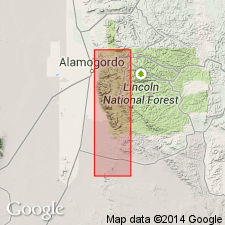
- Usage in publication:
-
- Gobbler formation
- Modifications:
-
- Areal extent
- Dominant lithology:
-
- Limestone
- Sandstone
- Shale
- AAPG geologic province:
-
- Orogrande basin
Summary:
Pg. 93. Gobbler formation of Magdalena group. Appears only on composite columnar section, Sacramento Mountains, Otero County, southeastern New Mexico. Consists of limestone, sandstone, and shale. Coarse quartz sandstone in lower part. Includes massive gray cherty Bug Scuffle limestone member which grades laterally into sandstone and shale. Thickness as much as 1,600 feet. Underlies newly named Beeman formation and overlies Helms formation. Age is Early(?) to Late Pennsylvanian (Morrowan? to Missourian).
[Notable exposures in Sacramento Mountains, Otero Co., southeastern NM.]
Source: US geologic names lexicon (USGS Bull. 1200, p. 1532).

- Usage in publication:
-
- Gobbler formation
- Modifications:
-
- Principal reference
- Dominant lithology:
-
- Sandstone
- Limestone
- AAPG geologic province:
-
- Orogrande basin
Summary:
Pg. 73 (fig. 20), 75-84, pls. (geol. maps). Gobbler formation of Magdalena group. Basal 200 to 500 feet consists of well-sorted quartz sandstone and limestone with black chert masses; contains Tertiary(?) intrusive sills. Upper 1,000+/- feet consists of contemporaneous, interfingering facies, the Bug Scuffle limestone member and unnamed detrital facies of shales and quartz sandstones. Total thickness 1,200 to 1,600 feet; 1,287 feet at type section. Underlies Beeman formation. Unconformably overlies Rancheria formation; deposited on a subaerial erosion surface, which in northern part of area was channeled locally to a depth of about 100 feet. Fossils. Age is Early(?) to Late Pennsylvanian (Morrowan? to middle Missourian).
Type section: measured in Mule Canyon and Long Ridge area, in NW/4 NW/4 sec. 14 and NE/4 NW/4 and NW/4 NE/4 sec. 15, T. 17 S., R. 10 E., northern Sacramento Mountains, U.S. Forest Service Lincoln National Forest base map (scale 1:31,680), 1941 ed., Otero Co., NM.
Named from Gobbler, a conspicuous dome (and trangulation station), in sec. 19, T. 18 S., R. 11 E., southern Sacramento Mountains, U.S. Forest Service Lincoln National Forest base map (scale 1:31,680), 1941 ed., Otero Co., NM.
Source: Publication.
For more information, please contact Nancy Stamm, Geologic Names Committee Secretary.
Asterisk (*) indicates published by U.S. Geological Survey authors.
"No current usage" (†) implies that a name has been abandoned or has fallen into disuse. Former usage and, if known, replacement name given in parentheses ( ).
Slash (/) indicates name conflicts with nomenclatural guidelines (CSN, 1933; ACSN, 1961, 1970; NACSN, 1983, 2005, 2021). May be explained within brackets ([ ]).

